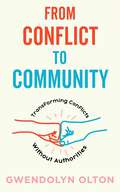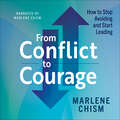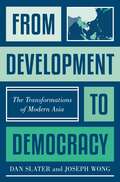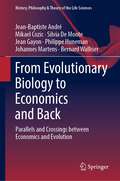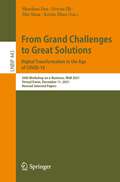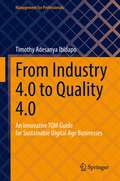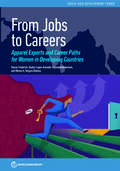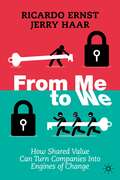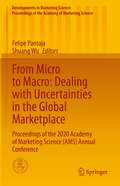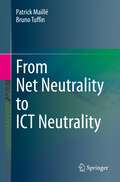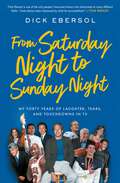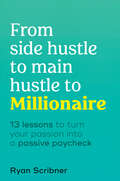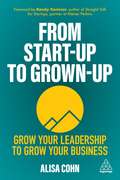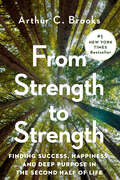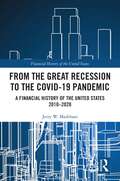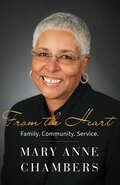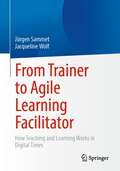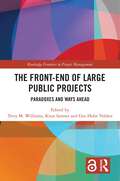- Table View
- List View
From Conflict to Community: Transforming Conflicts Without Authorities
by Gwendolyn OltonConflict is everywhere: our living rooms, our streets, our community organizations, and every corner of the internet. But few of us have the training to successfully intervene or resolve these conflicts. In these pages, experienced peacemaker Gwendolyn Olton shows you how to use your existing skills and intuition to transform a wide variety of conflicts from insurmountable impasses to working relationships where everyone's needs are met. The result is a practical, kind, realistic guidebook for anyone who's found themselves in a conflict (their own or someone else's) and wondered, "How did we get here and what can I do to make it better!?"The book is broken up into three sections: learn the basics of conflicts, help others work out their conflicts, and finally, resolve and heal the conflicts in your own life. Filled with real life examples and thought-provoking scenarios, Olton offers a variety of conflict analysis and conversation tools that you can use to navigate the most challenging interpersonal dynamics, and to better understand yourself and others along the way—all without calling HR or the cops.
From Conflict to Courage: How to Stop Avoiding and Start Leading
by Marlene ChismUnresolved conflict is workplace kryptonite. Learn how to develop the mindset and skills to defuse disagreements, overcome division, and turn conflict into an opportunity for growth.Unresolved workplace conflict wastes time, increases stress, and negatively affects business outcomes. But conflict isn't the problem, mismanagement is. Leaders unintentionally mismanage conflict when they fall into patterns of what Marlene Chism calls &“the Three As:&” aggression, avoidance, and appeasing. &“These coping mechanisms are ways human beings avoid the emotions that come with conflict, but in the end it's all avoidance,&” says Chism. In this book she shows how to fearlessly deal with conflict head-on by expanding your conflict capacity.Conflict capacity is a combination of three elements. The foundation is the Inner Game—the leader's self-awareness, values, discernment, and emotional integrity. The Outer Game is the skills, tools, and communication techniques built on that foundation. Finally, there's Culture—the visible and invisible structures around you that can encourage or discourage conflict. Chism offers exercises, examples, and expert guidance on developing all three elements. Leaders will discover techniques to increase leadership clarity, identify obstacles, and reduce resistance. They'll develop powerful skills for dealing with high-conflict people and for initiating, engaging in, and staying with difficult conversations. Readers will learn that when they see conflict as a teacher, courageously face it, and continually work on transforming themselves, they can get the resolution they are seeking. They can change minds.
From Development to Democracy: The Transformations of Modern Asia
by Dan Slater Joseph WongWhy some of Asia’s authoritarian regimes have democratized as they have grown richer—and why others haven’tOver the past century, Asia has been transformed by rapid economic growth, industrialization, and urbanization—a spectacular record of development that has turned one of the world’s poorest regions into one of its richest. Yet Asia’s record of democratization has been much more uneven, despite the global correlation between development and democracy. Why have some Asian countries become more democratic as they have grown richer, while others—most notably China—haven’t? In From Development to Democracy, Dan Slater and Joseph Wong offer a sweeping and original answer to this crucial question.Slater and Wong demonstrate that Asia defies the conventional expectation that authoritarian regimes concede democratization only as a last resort, during times of weakness. Instead, Asian dictators have pursued democratic reforms as a proactive strategy to revitalize their power from a position of strength. Of central importance is whether authoritarians are confident of victory and stability. In Japan, South Korea, and Taiwan these factors fostered democracy through strength, while democratic experiments in Indonesia, Thailand, and Myanmar were less successful and more reversible. At the same time, resistance to democratic reforms has proven intractable in Singapore, Malaysia, Hong Kong, China, Vietnam, and Cambodia. Reconsidering China’s 1989 crackdown, Slater and Wong argue that it was the action of a regime too weak to concede, not too strong to fail, and they explain why China can allow democracy without inviting instability.The result is a comprehensive regional history that offers important new insights about when and how democratic transitions happen—and what the future of Asia might be.
From Evolutionary Biology to Economics and Back: Parallels and Crossings between Economics and Evolution (History, Philosophy and Theory of the Life Sciences #28)
by Philippe Huneman Jean Gayon Bernard Walliser Mikael Cozic Jean-Baptiste André Silvia De Monte Johannes MartensThis book offers a comprehensive exploration of the major key concepts common to economics and evolutionary biology. Written by a group of philosophers of science, biologists and economists, it proposes analyses of the meaning of twenty-five concepts from the viewpoint respectively of economics and of evolutionary biology –each followed by a short synthesis emphasizing major discrepancies and commonalities. This analysis is surrounded by chapters exploring the nature of the analogy that connects evolution and economics, and chapters that summarize the major teachings of the analyses of the keywords. Most scholars in biology and in economics know that their science has something in common with the other one, for instance the notions of competition and resources. Textbooks regularly acknowledge that the two fields share some history – Darwin borrowing from Malthus the insistence on scarcity of resources, and then behavioral ecologists adapting and transforming game theory into evolutionary game theory in the 1980s, while Friedman famously alluded to a Darwinian process yielding the extant firms. However, the real extent of the similarities, the reasons why they are so close, and the limits and even the nature of the analogy connecting economics and biological evolution, remain inexplicit. This book proposes basis analyses that can sustain such explication. It is intended for researchers, grad students and master students in evolutionary and in economics, as well as in philosophy of science.
From Financialisation to Innovation in UK Big Pharma: AstraZeneca and GlaxoSmithKline (Elements in Reinventing Capitalism)
by Öner Tulum Antonio Andreoni William LazonickThe tension between innovation and financialisation is central to the business corporation. Innovation entails a 'retain-and-reinvest' allocation regime that can form a foundation for stable and equitable economic growth. Driven by shareholder-value ideology, financialisation entails a shift to 'downsize-and-distribute'. This Element investigates this tension in global pharmaceuticals, focusing on the two leading UK companies AstraZeneca and GlaxoSmithKline. In the 2000s both adopted US-style governance, including stock buybacks and stock-based executive pay. Over the past decade, however, first AstraZeneca and then GlaxoSmithKline transitioned to innovation. Critical was the cessation of buybacks to refocus capabilities on investing in an innovative drugs pipeline. Enabling this shift were UK corporate-governance institutions that mitigated US-style shareholder-value maximisation. Reinventing capitalism for the sake of stable and equitable economic growth means eliminating value destruction caused by financialisation and supporting value creation through collective and cumulative innovation. This title is also available as Open Access on Cambridge Core.
From Fossil Fuels to Low Carbon Energy Transition: New Regulatory Trends in Latin America (Energy, Climate and the Environment)
by Geoffrey Wood Juan Felipe Neira-CastroFocusing on five key themes - hydrocarbons, electricity, mining, social license to operate, and arbitration/dispute resolution- via in-depth country and regional case studies, this book seeks to capture the contrasting and sometimes conflicting trends in energy governance in Latin America as it wrestles with a dependence on fossil fuels whilst shifting toward a low carbon future. Energy transition continues to sit at the centre of the Latin American policy debate as the world continues to push for carbon neutrality by 2050. Latin America is undergoing a renewable energy transition, with substantial reserves (solar, wind, hydro, geothermal) and many countries in the region setting ambitious renewable energy policies, laws, and regulations to address climate change. However, recent initiatives to promote renewables must be placed in context. Historically, Latin America has developed and improved its economic and social standards due primarily to an economy based on the extractive industries and fossil fuels. This places renewables at the crossroads of multiple drivers, as the region seek to ensure security of supply, attract investment, and facilitate a low carbon energy transition.
From GOP to NFT: Anthony Scaramucci and the Launch of Flatter NFT
by Grace Headinger Lauren H. Cohen Richard RyffelAnthony Scaramucci, Managing Director of SkyBridge Capital, considered whether he should officially greenlight the launch of SkyBridge's own NFT platform - Flatter NFT. He had led the investment firm to push first into Bitcoin and then Ethereum to make SkyBridge a central node in the crypto industry. He further believed SkyBridge could differentiate itself from OpenSea and other platforms by tying non-fungible tokens with fungible experiences. The technology behind the platform was solidly proven. However, in his head he weighed the tradeoff between launching a full platform versus other ways of investing in the space. With a potential announcement of the platform pending for the September 2021 SALT NYC conference, Scaramucci believed now was the time to make a decision. The NFT space swelled in users and value by the day. Should SkyBridge jump in or move on to another venture?
From Grand Challenges to Great Solutions: 20th Workshop on e-Business, WeB 2021, Virtual Event, December 11, 2021, Revised Selected Papers (Lecture Notes in Business Information Processing #443)
by Shaokun Fan Noyan Ilk Zhe Shan Kexin ZhaoThis book constitutes revised selected papers from the 20th Workshop on e-Business, WeB 2021, which took place virtually on December 11, 2021.The purpose of WeB is to provide a forum for researchers and practitioners to discuss findings, novel ideas, and lessons learned to address major challenges and map out the future directions for e-Business. The WeB 2021 theme was “From Grand Challenges to Great Solutions: Digital Transformation in the Age of COVID-19.” The 8 papers included in this volume were carefully reviewed and selected from a total of 24 submissions. The contributions are organized in topical sections as follows: digital innovation and transformation, and e-commerce and social media.
From Industry 4.0 to Quality 4.0: An Innovative TQM Guide for Sustainable Digital Age Businesses (Management for Professionals)
by Timothy Adesanya IbidapoThis book describes the development of quality over various stages, from product inspection, through quality control to the present ISO 9000 systems. It also highlights the advantages of the quality management system (QMS) standards and the need for certification by organizations and enterprises/firms interested in taking advantage of the various benefits of these standards to improve their systems and aid their survival in a globally competitive market. The author provides simplified information to enable even those hearing the word ''quality'' for the first time to be able to appreciate and understand the various quality management philosophies irrespective of their background and position.
From Jobs to Careers: Apparel Exports and Career Paths for Women in Developing Countries (South Asia Development Forum)
by Stacey Frederick Gladys Lopez-Acevedo Raymond Robertson Vergara BahenaAn oft-cited strategy to advance economic development is to further integrate developing countries into global trade, particularly through global value chains, bolstered by the expansion of female-intensive industries to bring more women into the formal labor force. As a result, a frequent debate centers on whether the apparel industry--the most female-intensive and globally engaged manufacturing industry--can be a key player in this strategy. In recent decades, the apparel industry has shifted production to low-wage developing countries, increasing the demand for women, closing male-female wage gaps, and bringing women into the formal labor force from agriculture and informal work. But is an apparel-led export strategy sufficient to induce a broader transition from jobs women do to survive to careers promising stable employment and a sense of identity? 'From Jobs to Careers' answers this question by focusing on seven countries where apparel plays a vital role in their export baskets--Bangladesh, Cambodia, the Arab Republic of Egypt, Pakistan, Sri Lanka, Turkey, and Vietnam. It finds that the apparel industry indeed can serve as a launching pad to bring more women into the labor market. For this approach to work, however, complementary policies must tackle the barriers that hinder women's pursuit of long-term workforce participation and better-paid occupations. Key policy recommendations include increasing the participation of female production workers in export-oriented apparel manufacturing and associated industries, upgrading within manufacturing-related industries, boosting access to education, and breaking glass ceilings. The report also seeks to shift the paradigm of how we think of women in the labor force by stressing the importance of their transition from jobs to careers--the so-called 'quiet revolution.'
From Me to We: How Shared Value Can Turn Companies Into Engines of Change
by Ricardo Ernst Jerry HaarShared value is a management strategy in which companies find business opportunities in social problems. While philanthropy and CSR focus efforts focus on “giving back” or minimizing the harm business has on society, shared value focuses company leaders on maximizing the competitive value of solving social problems in new customers and markets, cost savings, talent retention, and more.This book takes the concept of shared value to the next level, with the concept of “Me to We” (also abbreviated as “M2W”) and discusses the current state of the business-environment-government relationship and shows how the shared value model can contribute to each entity. Citing real cases and examples from multiple industries, the authors show that shared value promotes shareholder interests while serving as a successful business strategy. Chapters explore the emerging phenomenon of shared value, the shareholder-stakeholder comparisons, the role of government in the stakeholder environment, shared value as it related to competitiveness, and operational issues such as implementation, communication, and leadership in their relationship to shared value.Readers will find useful strategies of Me to We and its implementation by firms that have become leaders in their market. They will receive ideas and insights into business strategies that will overshadow CSR activities as a differentiation or brand development strategy of the past.Featuring interviews with corporate executives offering their perspectives on shared value, this book will discuss shared value within the context of business and society, competitiveness, and globalization.
From Micro to Macro: Proceedings of the 2019 Academy of Marketing Science (AMS) Annual Conference (Developments in Marketing Science: Proceedings of the Academy of Marketing Science)
by Shuang Wu Felipe PantojaThe focus of the volume is on dealing with uncertainties and challenges within the global marketplace brought by digital technology companies that are leveraging artificial intelligence, machine learning, cloud computing, robotic automation, augmented reality, and other recent advancements. Additionally, these companies operate in the sharing economy and offer collaborative consumption opportunities. Featuring contributions presented at the 2020 Academy of Marketing Science (AMS) Virtual Annual Conference, the enclosed contributions assess the impact of these radical and disruptive innovations on long-standing incumbents and traditional industries, as well as consumer experiences. Founded in 1971, the Academy of Marketing Science is an international organization dedicated to promoting timely explorations of phenomena related to the science of marketing in theory, research, and practice. Among its services to members and the community at large, the Academy offers conferences, congresses, and symposia that attract delegates from around the world. Presentations from these events are published in this Proceedings series, which offers a comprehensive archive of volumes reflecting the evolution of the field. Volumes deliver cutting-edge research and insights, complementing the Academy’s flagship journals, the Journal of the Academy of Marketing Science (JAMS) and AMS Review. Volumes are edited by leading scholars and practitioners across a wide range of subject areas in marketing science
From Net Neutrality to ICT Neutrality
by Patrick Maillé Bruno TuffinThis book discusses the pros and cons of information and communication (ICT) neutrality. It tries to be as objective as possible from arguments of proponents and opponents, this way enabling readers to build their own opinion. It presents the history of the ongoing network neutrality debate, the various concepts it encompasses, and also some mathematical developments illustrating optimal strategies and potential counter-intuitive results, then extends the discussion to connected ICT domains. The book thus touches issues related to history, economics, law, networking, and mathematics. After an introductory chapter on the history of the topic, chapter 2 surveys and compares the various laws in place worldwide and discusses some implications of heterogeneous rules in several regions. Next, chapter 3 details the arguments put forward by the participants of the net neutrality debate. Chapter 4 then presents how the impact of neutral or non-neutral behaviors can be analyzed mathematically, with sometimes counter-intuitive results, and emphasizes the interest of modeling to avoid bad decisions. Chapter 5 illustrates that content providers may not always be on the pro-neutrality side, as there are situations where they may have an economic advantage with a non-neutral situation, e.g. when they are leaders on a market and create barriers to entry for competitors. Another related issue is covered in chapter 6, which discusses existing ways for ISPs to circumvent the packet-based rules and behave non-neutral without breaking the written law. Chapter 7 gives more insight on the role and possible non-neutral behavior of search engines, leading to another debate called the search neutrality debate. Chapter 8 focuses on e-commerce platforms and social networks, and investigates how they can influence users’ actions and opinions. The issue is linked to the debate on the transparency of algorithms which is active in Europe especially. Chapter 9 focuses on enforcing neutrality in practice through measurements: indeed, setting rules requires monitoring the activity of ICT actors in order to sanction non-appropriate behaviors and be proactive against new conducts. The chapter explains why this is challenging and what tools are currently available. Eventually, Chapter 10 briefly concludes the presentation and opens the debate.
From Saturday Night to Sunday Night: My Forty Years of Laughter, Tears, and Touchdowns in TV
by Dick EbersolA memoir by the legendary television executive detailing his pioneering work on Saturday Night Live, Sunday Night Football, the Olympics, the NBA, music videos, late night, and more.Think of an important moment in live TV over the last half-century. Dick Ebersol was likely involved. Dropping out of college to join the crew of ABC&’s Wide World of Sports, Ebersol worked the Mexico City Olympics during the famous protest by John Carlos and Tommie Smith as well as the Munich Olympics during the tragic hostage standoff. He went on to cocreate Saturday Night Live with Lorne Michaels and later produced the show for four seasons, helping launch Eddie Murphy to stardom. After creating Friday Night Videos and partnering with Vince McMahon to bring professional wrestling to network TV, he next took over NBC Sports, which helped turn basketball into a global phenomenon and made history as the first broadcaster to host the World Series, the Super Bowl, the NBA Finals, and the Summer Olympics in the same year; it was Ebersol who was responsible for Muhammad Ali lighting the Olympic flame in Atlanta. Then, following a plane crash that took the life of his fourteen-year-old son Teddy and nearly killed him, he determinedly undertook perhaps his greatest career achievement: creating NBC&’s Sunday Night Football, still the #1 primetime show in America. The Today show&’s headline-making hosting changes, the so-called &“Late-Night Wars,&” O.J. Simpson&’s Bronco chase—Ebersol had a front-row seat to it all. From Saturday Night to Sunday Night is filled with entertaining and illuminating stories featuring such boldface names as Billy Crystal, Michael Jordan, Bill Clinton, Jay Leno, Peyton Manning, Michael Phelps, and Larry David. (Ebersol even inspired the famous Seinfeld episode in which George Costanza pretends he didn&’t quit his job.) More than that, the book offers an insightful history and analysis of TV&’s evolution from broadcast to cable and beyond—a must-read for casual binge-watchers and small-screen aficionados alike.
From Side Hustle to Main Hustle to Millionaire: 13 Lessons to Turn Your Passion Into a Passive Paycheck
by Ryan ScribnerYour side hustle is waiting—get started! Anyone with the desire can start a side hustle, and there are more opportunities now than ever before. In 2017, YouTube personality and personal finance guru Ryan Scribner quit his day job to focus exclusively on his side hustle. By 2021, at the age of 26, he had become a millionaire. From Side Hustle to Main Hustle to Millionaire tells Ryan&’s story of transitioning from the 9-to-5 grind to a liberating and lucrative career as a self-employed business owner—and gives you the tools to launch a side hustle too. In 13 simple lessons, Ryan shares what it takes to leave the workforce behind, follow your passions, and earn passive income. Learn how to build a successful side business that you can grow to your main source of income over time, with specific guidance on each step of the process, including: How to embrace frugality and set yourself up for financial successWhat to consider when choosing a side hustle—with suggestions for identifying untapped marketsWhy a good mentor is important—and how to find oneStrategic steps to grow your audience or customer baseWhen and how to diversify into other assets and create passive revenue streams
From Start-Up to Grown-Up: Grow Your Leadership to Grow Your Business
by Alisa CohnEvery start-up founder feels overwhelmed and uncertain at various times. The key to managing the relentless turmoil of a start-up is learning to manage yourself. From Start-Up to Grown-Up gives you, the founder and CEO of a great start-up, the knowledge and experience that executive coach Alisa Cohn has gained from helping companies such as Etsy, Foursquare, InVision and The Wirecutter become headline names. Growth of your company begins with growth within you. The book provides you with effective and practical ways of maximizing your strengths, defusing your triggers, controlling your self-doubt and building on your motivators. With these self-management tools, you can then turn your attention to managing your team by ensuring the flow of communication and finding the joy of delegation and the soul in meetings. Finally, you gain practical tools for managing the company and ensuring overall effectiveness of your team and strategy, using specific scripts you need to have delicate or difficult conversations.Filled with stories drawn from the author's experience, From Start-Up to Grown-Up helps you build a company with a set of core values that everybody lives by and where everyone shares a vision of where the company is going and how to get there.
From Strength to Strength: Finding Success, Happiness, and Deep Purpose in the Second Half of Life
by Arthur C. BrooksThe roadmap for finding purpose, meaning, and success as we age, from bestselling author, Harvard professor, and the Atlantic's happiness columnist Arthur Brooks. <p><p> Many of us assume that the more successful we are, the less susceptible we become to the sense of professional and social irrelevance that often accompanies aging. But the truth is, the greater our achievements and our attachment to them, the more we notice our decline, and the more painful it is when it occurs. <p><p> What can we do, starting now, to make our older years a time of happiness, purpose, and yes, success? <p><p> At the height of his career at the age of 50, Arthur Brooks embarked on a seven-year journey to discover how to transform his future from one of disappointment over waning abilities into an opportunity for progress. From Strength to Strength is the result, a practical roadmap for the rest of your life. <p><p> Drawing on social science, philosophy, biography, theology, and eastern wisdom, as well as dozens of interviews with everyday men and women, Brooks shows us that true life success is well within our reach. By refocusing on certain priorities and habits that anyone can learn, such as deep wisdom, detachment from empty rewards, connection and service to others, and spiritual progress, we can set ourselves up for increased happiness. <p><p> Read this book and you, too, can go from strength to strength. <p> <b>New York Times Bestseller</b>
From the Great Recession to the Covid-19 Pandemic: A Financial History of the United States 2010-2020 (Financial History of the United States)
by Jerry W. MarkhamThis volume narrates the financial history of the United States during a period of great upheaval in the early part of the twenty-first century. It is divided into three chronological sections: the first section describes the recovery of financial markets after the Great Recession. It begins with an overview of the state of the economy at the start of the new decade, including some of the political storms affecting the economy and financial markets. It explores the uneven nature of the recovery and volatility in the Treasury during these years. The second section sets forth regulatory responses to the Financial Crisis of 2008, including the massive fines imposed on large banks by a swarm of regulators. It examines the ‘too big to jail’ prosecution model, cases involving Libor and foreign exchange manipulation, and the impact of rogue traders. It also looks as developments in payment systems, and the rise of crowdfunding as a source of capital, and high-frequency trading. And the third section describes the rules adopted under the Dodd-Frank Act of 2010 that broadly affected financial markets. It also recounts the Trump trade wars and ends with an account of the financial and economic turmoil that occurred during the Covid-19 pandemic in 2020. The volume will be essential addition to academic and public libraries with readers drawn from business schools, departments of economics and finance, and historians.
From the Ground Up: Building a Dream House---and a Beautiful Life---through Grit and Grace
by Noell JettBuilt by hand. Built to last. The best dreams start with love.Noell Jett&’s home is more than a farmhouse. It&’s a testament to overcoming challenges, working side by side with those you love, and learning to say yes to your dreams again and again, even when the world says no.Growing up in poverty, in a family with extremist religious beliefs, Noell Jett knows what it&’s like to work hard to survive. When she married Daniel and they began a family together, she discovered the joy of working hard to achieve her dreams.In From the Ground Up, Noell shares the unbelievable story behind her 3,700-square foot custom farmhouse—built by hand and savvy influencer marketing—and the key strategies she learned about never giving up. With beautiful photos, reflections questions, and Noell&’s trademark DIY tips, From the Ground Up offersa vision for living beyond the confines of your past,inspiration for home renovation on a budget,tricks to make influencer marketing work for you,spiritual insight into finding true freedom, andencouragement to take that life-changing leap of faith.From the Ground Up is a powerful reminder that following your passion is worth a few sacrifices along the way. After all, some dreams are worth giving it all you&’ve got. Why not follow yours?
From the Heart: Family. Community. Service.
by Mary Anne ChambersA refreshing memoir that challenges readers to make the most of life’s opportunities.After moving to Canada from Jamaica in 1976, a colleague at Scotiabank told Mary Anne Chambers not to be surprised if she didn’t get very far. The overlapping characteristics of her identity — Caribbean immigrant, Black businesswoman, Catholic, wife, and mother—were expected to hinder her both personally and professionally. Yet, against all odds, she went on to attain senior roles in both business and politics.In her inspiring memoir, Chambers shares lessons from the moments that challenged and defined her. From the Heart encourages us to be our authentic selves, to embrace curiosity, to find value in our life experiences and those we meet along the way.
From Trainer to Agile Learning Facilitator: How Teaching and Learning Works in Digital Times
by Jürgen Sammet Jacqueline WolfPure face-to-face training is increasingly being supplemented or even replaced by modern forms of learning such as blended learning, online training, e-learning and informal learning. What does this mean for you as a trainer (lecturer, speaker, personnel developer)?This reference book shows how the job description of the trainer is changing due to digitalisation and which competences you need as a trainer to be successful in the "learning revolution". After all, specialist knowledge paired with classroom didactics is no longer enough.This work takes you by the hand to become a learner again as a trainer and to develop into an "agile learning facilitator". It gives you orientation in the digital "trainer competence jungle". In a practical and clearly understandable way, you will receive both theoretical background knowledge and practical implementation possibilities for the modernisation of your continuing education programme.
The Front-end of Large Public Projects: Paradoxes and Ways Ahead (Routledge Frontiers in Project Management)
by Terry M. WilliamsLarge public projects represent major complex investment and whilst there has been much written about how to develop, manage and deliver such projects, practice still does not match up with expectations. In this book, researchers from the Norwegian Concept Research Programme explore the paradoxes between theory and practice in collaboration with experts in the field of project governance. This book delves into the reality of large public projects, to show how they can be managing effectively and efficiently, recognising the realities of their context. It offers a range of practical conclusions as to the paradoxes of the governance and management of public projects. The international spectrum of authors draw their examples from the UK, Norway, Canada, France, Australia and the Netherlands. Bridging the gap between research, theory and practice, this book will benefit academics and researchers in the field of project management and corporate governance as well as those in the practice of public project governance, civil servants and industry practitioners.
Führen in der Arbeitswelt der Zukunft: Instrumente, Techniken und Best-Practice-Beispiele
by Swetlana FrankenIn ihrem Lehrbuch beschreibt Swetlana Franken umfassend die Veränderungen der Arbeitswelt, die vor allem durch die Digitalisierung und den Generationenwechsel verursacht wurden. Sie stellt traditionelle und moderne Führungskonzepte vor und beschreibt ein 4D-Modell der modernen Führung. Dieses Modell integriert Digitalisierung, Demografie- und Diversity-Orientierung sowie Demokratisierung und Dynamisierung der Führung. Anhand von Forschungsergebnissen und Praxisbeispielen aus innovativen Unternehmen beschreibt Swetlana Franken die Auswirkungen des Modells auf effektive Führungsmethoden und geeignete Führungstechniken sowie deren Umsetzung. Studierenden der Betriebswirtschaftslehre, vor allem im Bereich Personalmanagement, aber auch Führungskräften vermittelt das Buch die notwendigen Kenntnisse, um in der modernen Arbeitswelt ihrer zentralen Rolle als Initiatoren und Architekten der Veränderungs- und Gestaltungsprozesse gerecht zu werden.In der zweiten Auflage werden die Erfahrungen und Erkenntnisse der letzten Jahre in Form von aktualisierten Ausführungen und praktischen Beispielen aufgegriffen. Wichtiger gewordene Themen wie hybride Arbeitswelt und Remote Work, Generationenvielfalt und Multikulturalität, Nachhaltigkeit und digitale Geschäftsmodelle, Umweltprobleme und Abhängigkeit von globalen Wertschöpfungsstrukturen werden berücksichtigt.
Führung in der Digitalisierung – Mit Sinn und Selbststeuerung: Führung wird nicht überflüssig, aber die ändert sich gravierend (essentials)
by Dominique René Fara Sibylle Olbert-BockZahlreiche Unternehmen setzen auf agile Organisation. In der Umsetzung stellt sich immer wieder die Frage des „wie weiter“, um wirklich auf ein neues Level zu kommen. Wichtig ist der Fokus auf eine konsistente Ausrichtung und Umsetzung von Agilität in der Gesamtführung. Hier setzt das Buch an. Es geht auf die oft zunächst operative Umsetzung von agilen Arbeitsweisen ein und spannt den Bogen zu einer strategisch, strukturell und normativ durchdachten Gesamtkonzeption. In einfachen Geschichten und Bildern wird gezeigt, was Digitalisierung und agile Arbeitsweisen für die Führung in Organisationen bedeutet. Es wird ein leicht verständliches Gesamtbild von zukunftsweisender Führung entworfen. Seine Bestandteile werden entlang von Beispielen aus Sport, Startup-Welt und traditionellen Organisationen erklärt, und es werden konkrete Möglichkeiten geboten, die Umsetzung anzugehen.
Führung von Morgen: Werteorientiert, kundenfokussiert, nachhaltig (Fit for Future)
by Burkard SchemmelZum ersten Mal in der Geschichte entsteht eine globale Wirtschaft auf der Basis universeller digitaler Geschäftsmodelle. Erfolgreiche Unternehmen haben ihre Produktlebenszyklen beschleunigt, die Aktivitäten strikt auf den Kunden ausgerichtet und neue Geschäftsmodelle schneller als je zuvor entwickelt. Führungskräfte benötigen einen Kompass, um sich in diesem digitalen Polypol zurechtzufinden - vom Verständnis des aktuellen Kontextes und der Makrofaktoren über Beispiele erfolgreicher Unternehmen bis hin zu einem bewährten Modell, das Organisationen hilft, sich durch den Wandel zu bewegen.Dieses Buch zeigt Führungskräften, wie sie die Transformation gestalten können. Führung heißt, den Wandel als Marathon zu begreifen und mit agilen Sprints die Transformation zu orchestrieren. Diejenigen werden am erfolgreichsten sein, die langfristig am großen Ganzen arbeiten und in der Umsetzung maximal agil sind. Sie konzentrieren sich auf die „richtigen“ Sprints, die der langfristigen Vision den entscheidenden Schub geben.
